RACE REPORT! Leadville Trail 100 MTB and Will I Go Back?
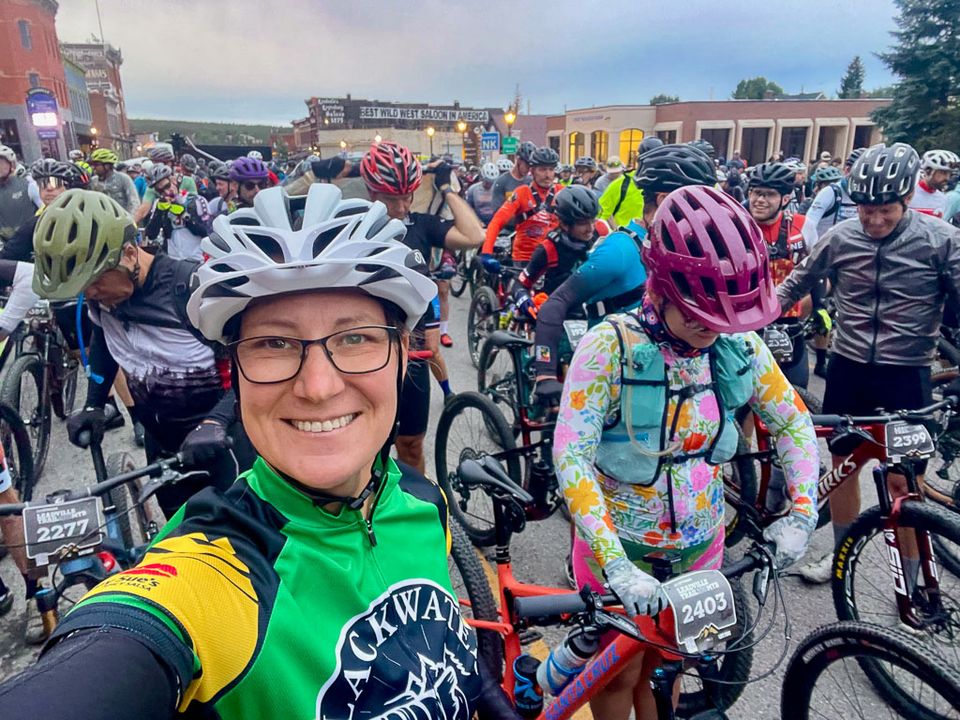
Upon Reflection
As much as I'd like to, it's impossible to express every glorious, tedious, and exhilarating moment from this year's LT100 MTB Race. So consider this race report a collection of highlights, the standout moments where I learned the most and those I'll cherish when age and immobility have me looking back and saying, "Well, at least I did that."
This race signifies more than a mythical cycling event or physical challenge. The aspiration to finish in twelve hours, to earn the small belt buckle and the finisher's medal, isn't driven by bragging rights. For most of us mere mortals, it is a test of spirit, with the 12-hour course symbolizing life's peaks and valleys as we navigate our short time on this magnificent planet.
The White Corral
In 2023, The Leadville Trail 100 MTB startline would boast 1,787 riders of varying fitness levels and skills, from elite pros who finish in half my anticipated time to newbies like me. Some participants have completed the race numerous times, even annually, since its inception 29 years ago, creating an awe-inspiring dynamic as we face down the same course under ominous skies, dancing in place between the raindrops to keep warm. It's a powerful energy.
Yet, this diversity can lead to challenges out on course. The race organizers have historically arranged racers into colored corrals based on skill levels. The corrals range from gold and silver at the front to intermediate groups of red, green, purple, orange, blue, and white at the back—where I found myself.
In most years past, a rifle blast by Ken Clouber marked a mass start, with every rider surging down 6th Street at once like a stampede, making for one heck of a photo op. However, this often led to bottlenecks at the initial climb and other tricky parts of the course. Thus, in 2021, a wave start system was introduced, with 2.5-minute intervals between each corral's departure. My group's white corral was subdivided into three self-organized waves and represented almost ⅓ of the racers.
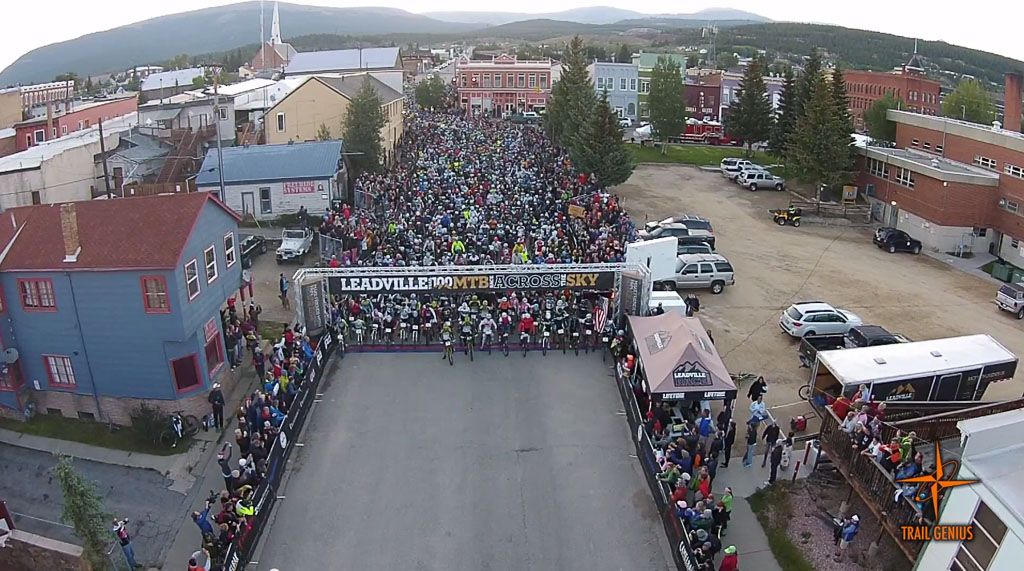
While some call it an 'alarm clock race' back in the white corral, I call it lucky that my dog wakes me up at 5 a.m. every day, making getting up at 4 a.m. not that much of a stretch.
On race day, despite an uneasy sleep, I was relatively calm. Even with all the logistical challenges triggered by the van upset, my awesome support crew and I met our preparation deadlines! Chrissy and I spent the night before preparing Scratch Super High-Carb Drink Mix and packing aid station supplies. I'd already worked with Stro to sort tools and spares for the aid stations; the food was also ready, and that evening, I managed a quick check on the bike's bolts and secured the race bib.
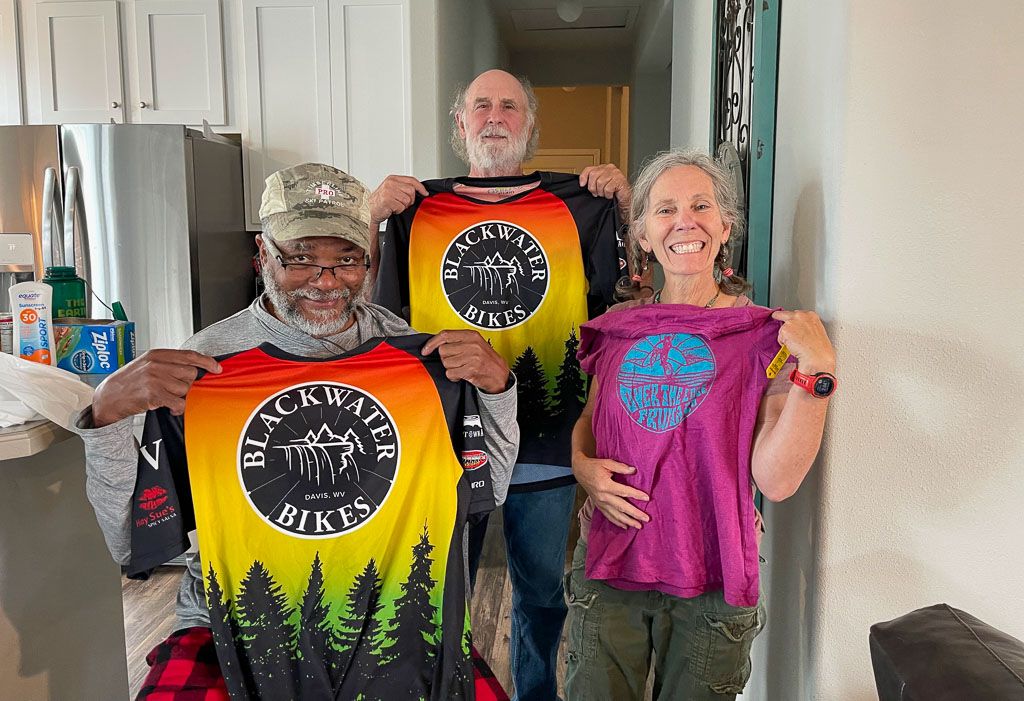
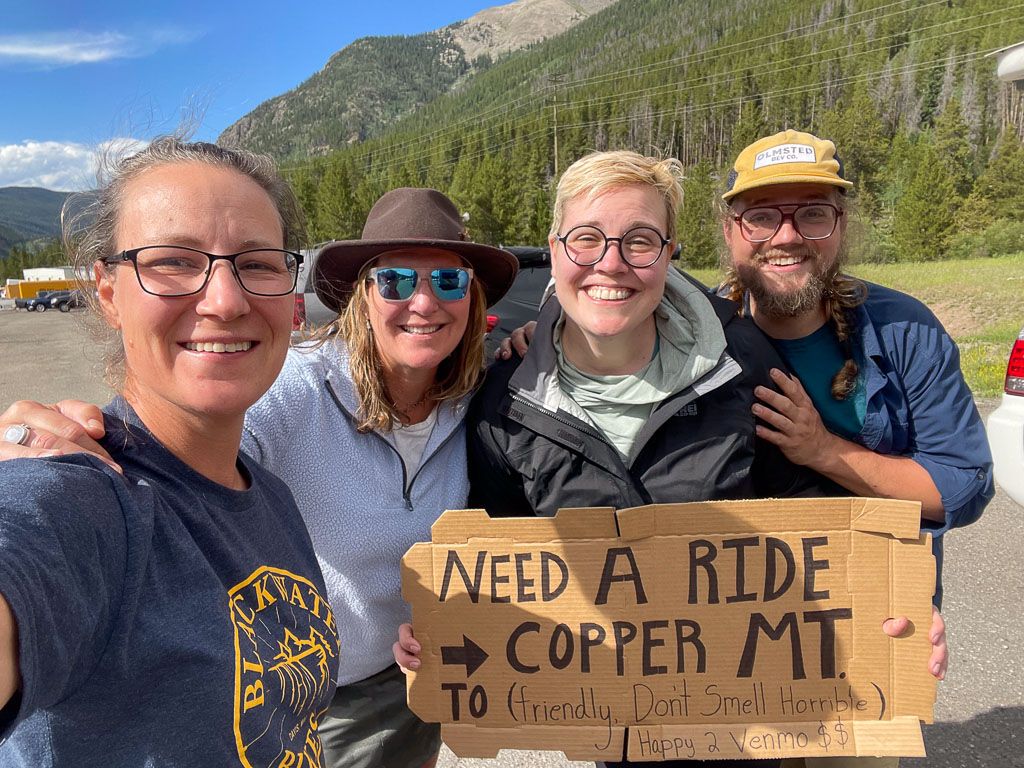
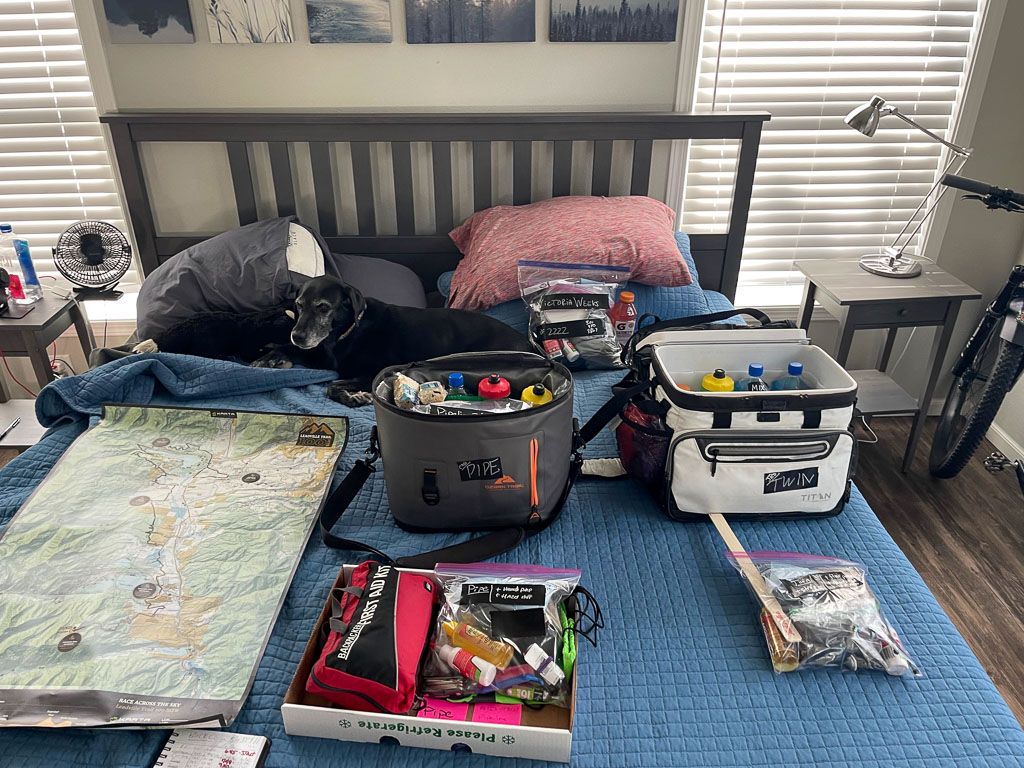
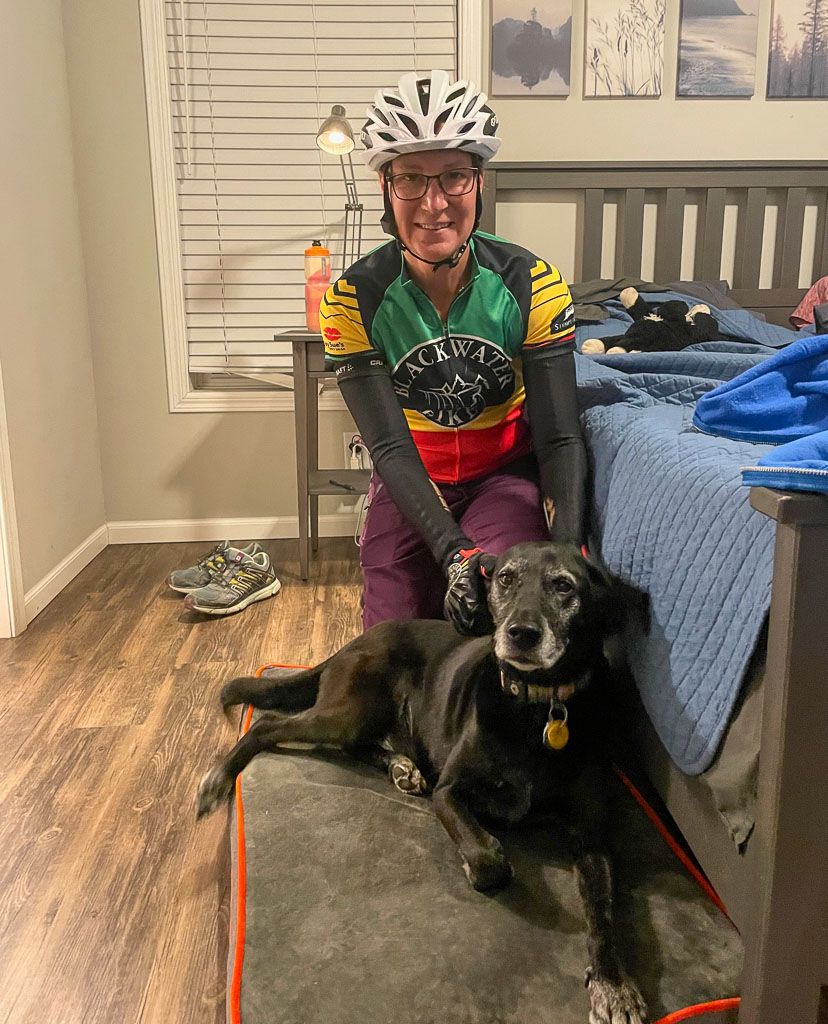
Top Left: Stro, Ed, and Chrissy are planning their brightly colored outfits for race day. Top Right: On our way to Ford to drop off my van for diagnosis, Cass and I helped two inspiring backpackers get from Leadville to Copper. Bottom Left: Coolers and dropbags prepped for race day. Bottom Right: Saying goodbye to Hazel before heading to the start line!
By 4:15 a.m., I'd consumed my customary banana/blueberry/beet smoothie and a portion of pre-race rice with raisins, cinnamon, maple syrup, and coffee. After a quick blog post, I said goodbye to my dog Hazel and handed her over to Cass for the day. Ed had a flawless plan to drop me at the start, and I made it to the first wave of the white corral.
I was stoked! I wore an oversized blue hoodie to stay warm, which I planned to donate to the crowd once the race began. Beside me stood a man who raced motorcycles in the Blackwater 100, a famous off-road motocross and ATV race in my town of Davis, West Virginia, from 1975 to 1993—what a small world! He held his wife's spot, who was trekking to the outhouses. Sipping on Gatorlyte, I, too, headed to the blue lagoon. Returning to my spot proved trickier than expected. As we neared the 6:30 a.m. start, I strained to hear the tail end of the national anthem but missed Ken and Merilee's legendary motivational speeches due to audio challenges.
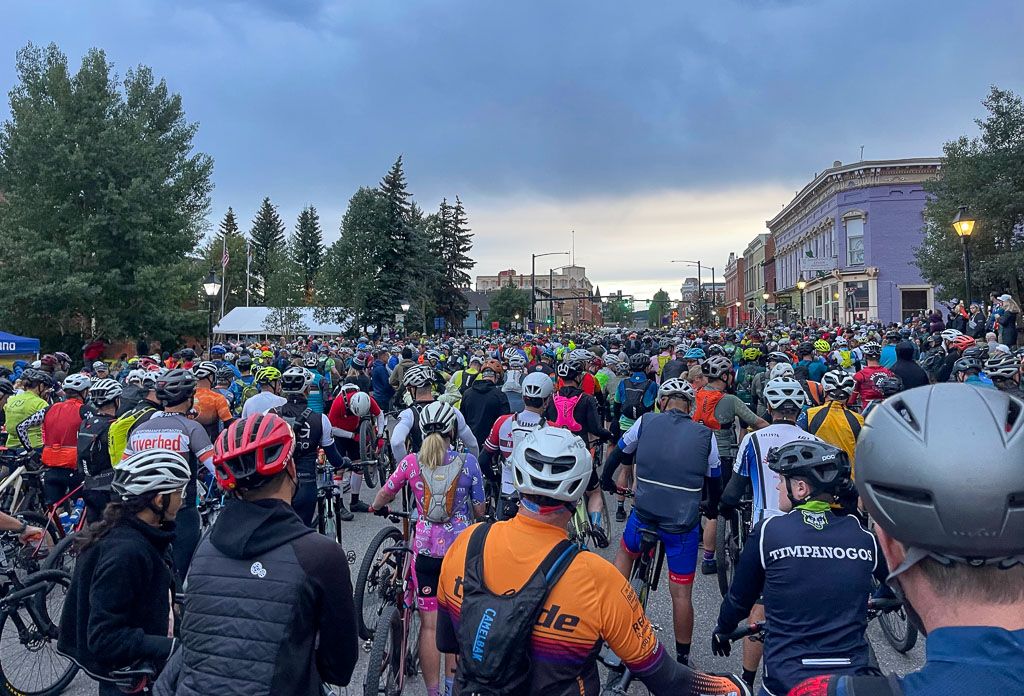
Boom! Ken fired the gun. The sound was faint back in the white corral, a bit anticlimactic. Gold and silver were off! Slowly, we moved up to the next corral position. After 2.5 minutes, the next corral took off. The process repeated until finally, I turned onto 6th Street, ready to pedal in the white corral. Except, somehow, I ended up in the second wave. Failing to notice racers passing me during the staccato start, I lost my spot. Another 2.5 minutes passed. Finally, I could ride.
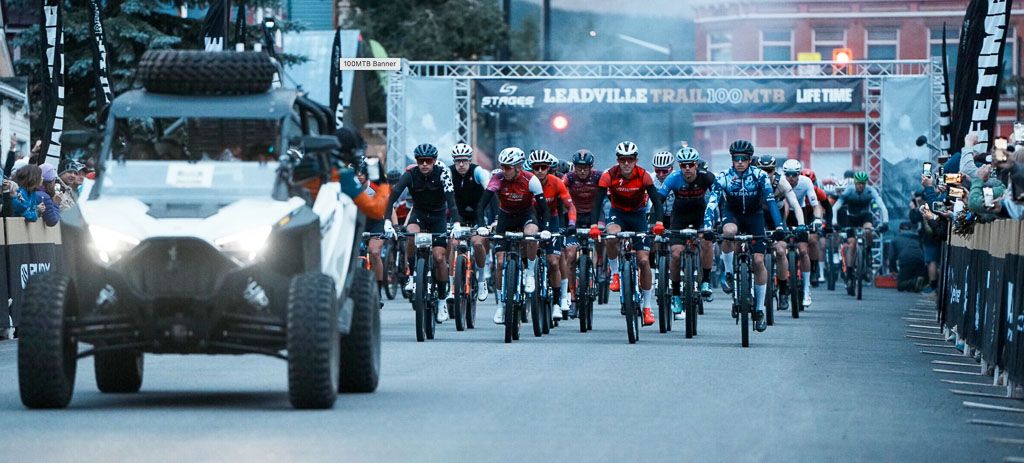
The First Climb
Crossing the tracks onto 9A and finally turning onto the dirt, I felt like I'd come home. I'd camped on this road twice and pre-ridden it twice as well. Thanks to the rainstorm the night before, it was in the best shape I'd seen it, beautifully darkened by moisture, tacky, and almost dust-free. Any puddles were easily avoidable. I shifted up and could finally use some pent-up energy in my legs after the predominantly downhill start. The sky threatened to open up at any moment, but thankfully, the clouds held on to their heavy loads and let us all focus on the trail.
The group had spread out, and I made up some time here. My heart rate might not agree, but I felt surprisingly relaxed. This is what I'd trained for, anticipated, and dreamt of. The only sound was knobby tires over fine gravel. Pedaling this first dirt road in the brisk morning air was like a rolling group meditation. But the smooth gravel gradually morphed into a finicky 4x4 road. At mile six, the first climbing test of the day was upon us.
I'd been here before. I knew I had the power to clean this entire section, especially on a cool race morning after such a long taper. But it was not meant to be. The steepest part of the grade is around 13%, with an average of 6.3%. The road continued disintegrating beneath us, with ruts, loose dirt, and large rocks becoming our surface. As on most of the rocky ascents on this course, there is a prominent line threading through the chaos. But there is also a wall of people almost trail-wide, many walking. I'm unsure what gave way first, the line or my momentum, but I had to dismount.
It was way too early for this. I wanted to keep pedaling. It may sound like an excuse, but this traffic jam is the harsh reality of starting in the white corral. I decided to take my first nature break since I was off the bike anyway. Despite every effort, I woke up slightly dehydrated and tried to compensate in the morning.
The Dreamchaser
Someone always has to start last. For the last seven years, it has been Ty Hall, and he does it on purpose, for he should be starting up much further in the corrals—this year, he finished the race in 8:24:49! His time proves that with enough skill and fitness, one can easily overcome the back-of-the-pack start and have a fantastic finish. But Ty doesn't do this to prove a point. He's known as the Dreamchaser, and he rides for a purpose much greater than himself—The Leadville Trail 100 Legacy Foundation, and thereby, Leadville's community, education, recreation, and economic vitality.
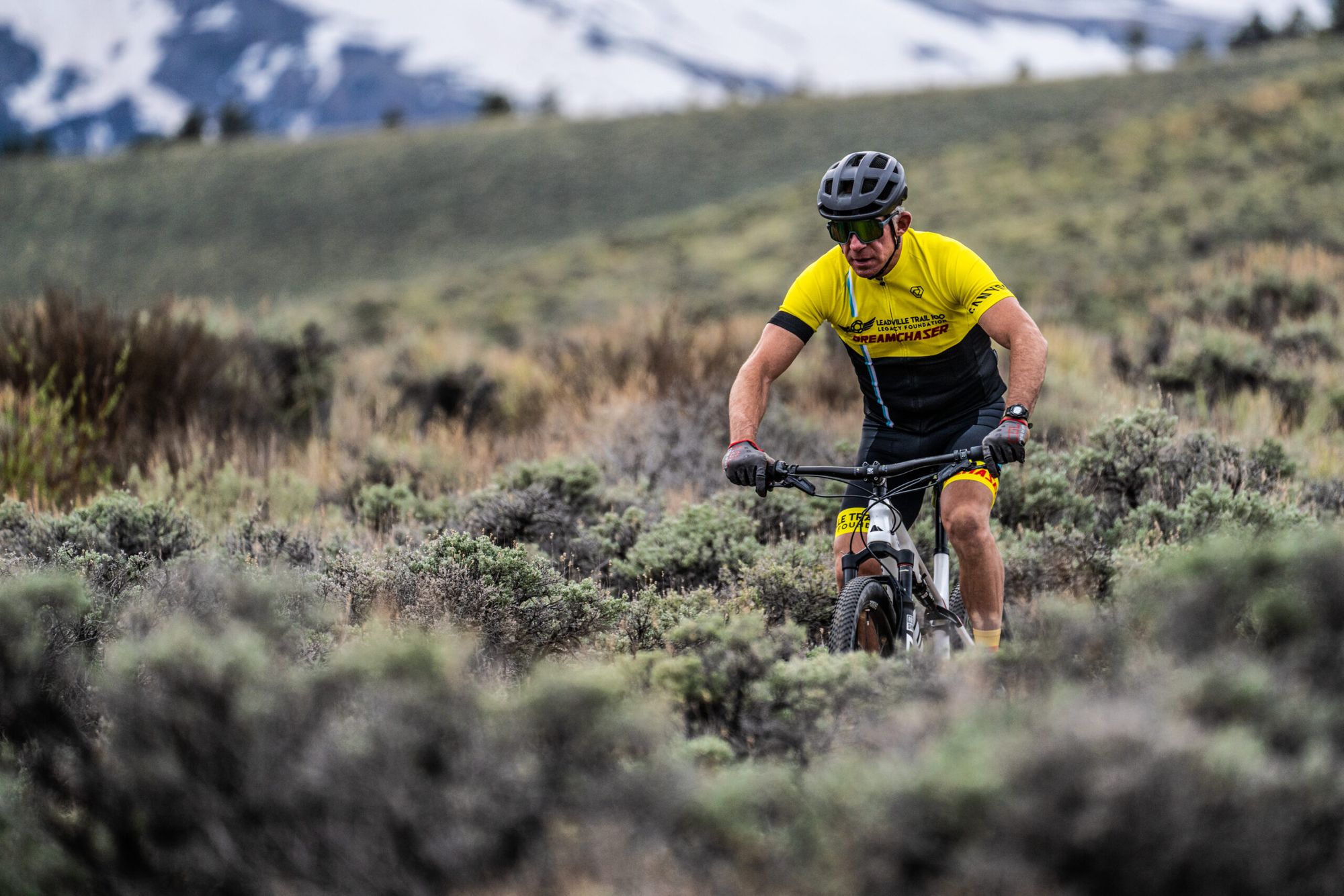
Each racer can join Ty Hall's mission by pledging a small amount of money per rider he passes. He passed 1,537 athletes this year, raising tens of thousands of dollars! Ty flew past me on the gravel before St. Kevin's. I shouted in support; seeing him humbly show us how it's done was almost amusing.
Heroes en Route
As the founders of the original LT100 foot and MTB races, Ken Chlouber and Merilee Maupin are heroes of Leadville lore. Recently, Ken has experienced some health problems, but he still makes every effort to rouse the crowd at athlete meetings and startlines. Merilee has her "corner" of the course, shouting encouragement and directions to racers descending from Carter Summit. Shortly after passing by Merilee, I came upon Ken, sitting in a camp chair, vigorously waving his walking stick and calling out cheers to riders. I had yet to meet Ken or Merilee, so I took this chance to shout back with the loudest "Thank you, you rock!" I could muster. I might've repeated myself a few times. I heard Ken laugh with gusto:" You rock!" It was a huge emotional boost that carried me all the way up Sugarloaf to the top of Powerline with a smile on my face.
Certain milliseconds burn themselves into our memories, and that vision of Ken coming out to support the riders despite whatever ailments he might be dealing with is one I'll never forget. At that point, I had every intention of seeing Merilee again at the finish, where she welcomes every racer who crosses the line with a hug and a finisher's medal.
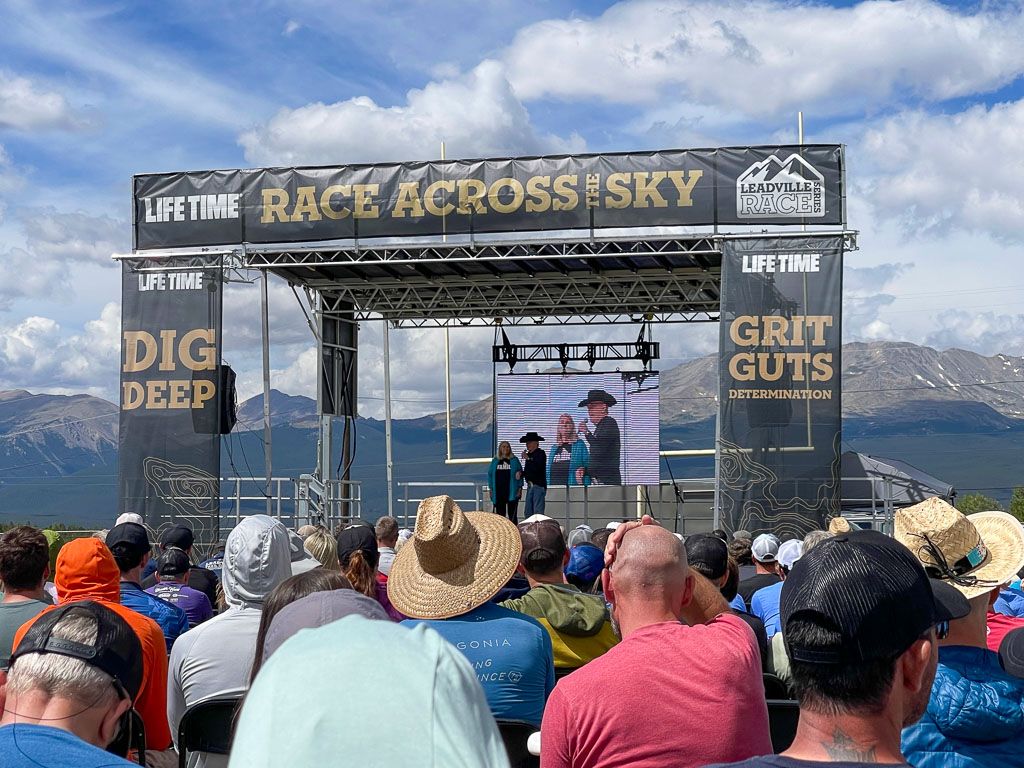
Facing Down an Ambulance on Powerline
At around mile 19, I crested the top of Powerline, more than ready to take on the descent. The next few miles are some of the most famous of the race—a rocky, deeply rutted 4x4 access road weaves through the towering, buzzing powerlines. I'd been here just days before on a pre-ride, and this time, I had even better tires for the job. Leadville had experienced two inches of rain shortly after my pre-ride, so I expected a significant upset to the terrain. Even so, I felt my confidence as a mountain biker take over; it was time to have fun.
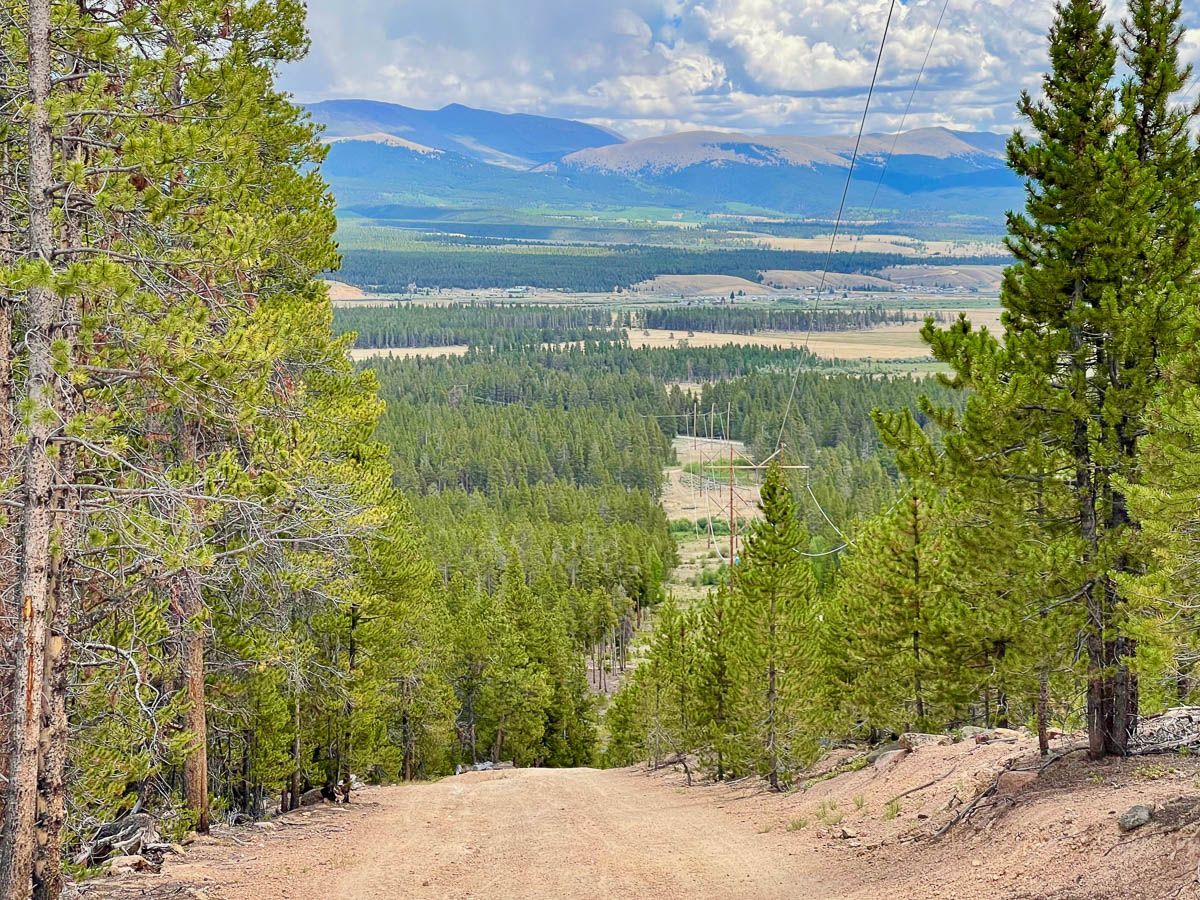
This decent remains one of the highlights of the day. The road held itself together even after the rain. There were other riders, but there was plenty of room for me to choose my line and stick to it. When my wrists were about to revolt, a short climb stepped in for some welcome relief. As I crested to face the steepest section of the descent, I saw vehicles ahead! Flashing lights, red and blue. An ATV was on the right side of the trail, and a 4x4 ambulance was climbing directly toward me and a fellow rider. I had enough time to pick a line and get out of the way, stopping to let the EMT direct my next move. I was extremely grateful that I'd replaced my brake pads and rear rotor before the race!
As I exited the scene, I quickly glanced at the injured rider. It could be any of us, and I admit my enthusiasm for the decent waned a bit. I voiced an Erbe-ism that I've adopted out loud: "Keep it together, Weeks." I safely reached the bottom of Powerline, and the following tarmac looked pretty inviting.
Aid Station Drama
As if riding 105 miles up to 12,516 feet with 11,928 feet of vertical isn't hard enough, the LT100 MTB race has a time cap of 12 hours. Traditionally, riders who finished within 13 hours got a finisher medal and completion time. Completing under 12 hours earns you the small belt buckle, and finishing under nine hours results in the big buckle.
This year, it turns out, riders who did not complete the race within 12 hours received an official DNF—Did Not Finish—even if they crossed the line in under 13 hours, got a hug from Merilee, and a finisher's medal draped around their neck. I might be dipping my toe into some controversy here, but now I know why it was so hard to find any information that had the 13-hour finish as a possibility, which is a big reason I set my sights on a 12-hour finish.
Race officials keep track of riders' times at 13 points throughout the race via the chip in the race bib attached to the bike. If a racer misses one of these timing stations, they are disqualified.
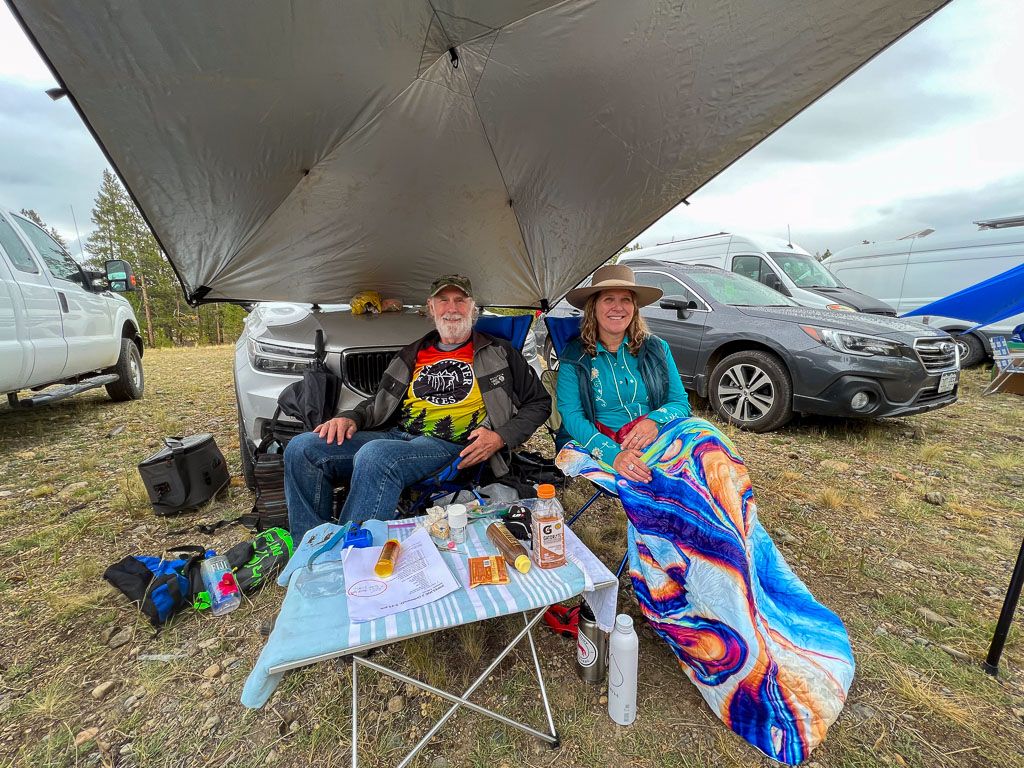
The Pipeline aid station at mile 28.5 was my first opportunity to see my crew. Ed and Cass were waiting with fresh bottles, gels, and snacks. I'd gone through most of my drink mix, so this was an important stop. I followed the pink flags, and my eye caught a photographer. I then turned onto the large open area lined by vehicles. I'd also pre-ridden this; I knew to start looking for them. It took me about 30 seconds to realize all the people and tenttops were one row of cars over. What!?! I was outside the aid station and had already passed almost half of the crews.
I quickly turned and weaved between cars, tents, dogs, and other crews to pop out on the course. I looked up and down for my crew; I couldn't pick them out immediately. I started calling their names, then straight up screaming, "TCT! TCT! TCT!" I can't say why I chose to shout this particular Erbe-ism over their names. Panic. Shit! My options were to ride back to find them or continue riding to the next aid station, only 11 miles away. I had to keep moving forward! I got back on my bike and on course. I wasn't going to dehydrate in 11 miles. Almost immediately, I spotted my crew—apparently, some of the expletives I was also shouting caught enough attention to get their attention.
Ed and Cass kicked it into high gear. Ed attended to my chain, which had accumulated plenty of dust despite the moist trials. Cass swapped bottles and food, and I chugged some Gatorlyte. I don't know the exact time, but I felt like I was stopped for less than sixty seconds once I found them.
I'm not sure how much time I lost in that kerfuffle, and it wasn't until 20 miles later, grinding up the Columbine climb, that I realized an even more detrimental issue than lost time. I didn't cross the Pipeline timing mat. I was probably disqualified. I put the thought out of my head. I could do nothing about it, so I just kept pedaling.
I didn't know that once Ed and Cass finished attending to me, Cass attended to the DQ issue. She immediately approached an official and explained what happened. She brought in a few witnesses (who says cursing loudly doesn't get you anywhere in life?), and they confirmed a crazy lady popped out from behind the cars looking for her crew. There's only one race result worse than a DNF: a DQ. I was spared that disgrace thanks to Cass and an understanding race official.
Race to Twin Lakes via Singletrack Bliss
Adrenaline officially topped off after the Pipeline drama; I pedaled for my life on the straight gravel road that provides access to the Pipeline. I had enough time to think about the next challenge and do some quick calculations. I would have to fly to make it to the first cutoff in time.
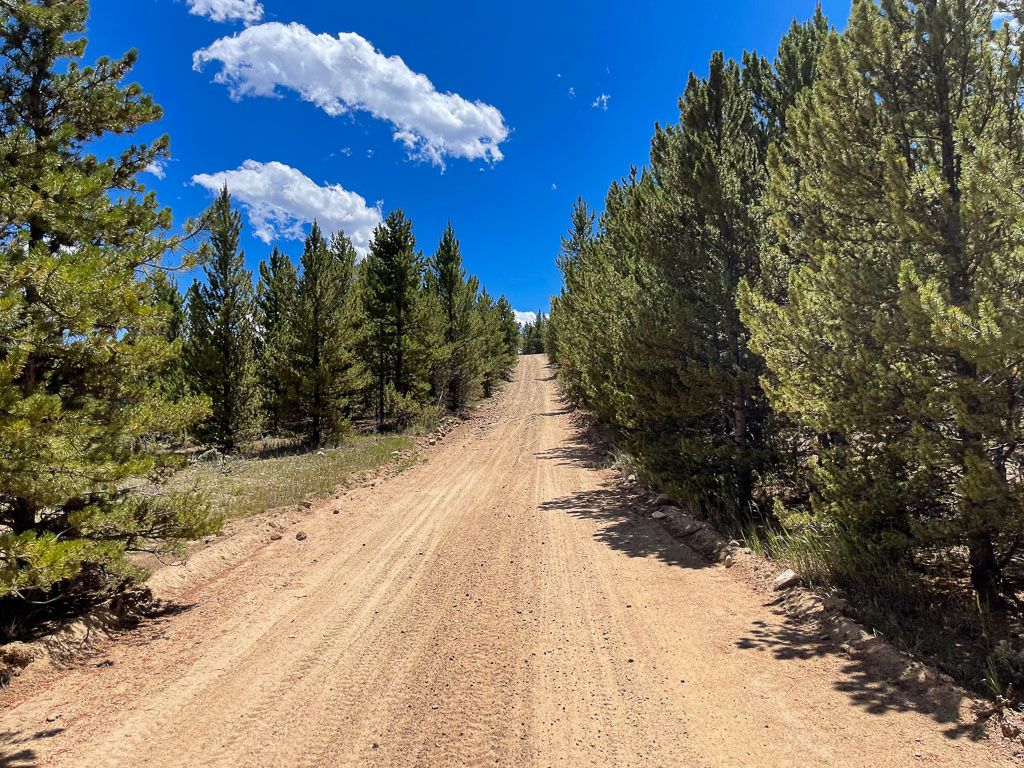
Cutoff, you ask? Yep. There are four points throughout the race where riders are pulled from the course if they haven't made the time cutoff. The cutoffs are in place to ensure riders aren't out on the course past dark or past their ability to get home safely. These cutoffs consider the race's start time, not the rider's chip time. While the wave starts are also acknowledged, there is no question that the further up in the corral you are, the more likely you are to make the cutoffs. Corral positions are defined either by the rider's previous year's LT100 finish time or a time in other qualifying races. So yes, the newbies and the least fit also have the least time to make the cutoffs, including the finish. It's a harsh reality of the race, but one I was well aware of.
So I had to book it to Twin Lakes. Once again, my pre-ride paid off. I knew what was coming as I rounded each corner, and all the fuel I'd consumed so far was working. I was in a race against time, but I was racing! We were also dipping into our lowest elevation of the day, so riding below 10,000 feet helped, too.
Soon, I came upon another iconic section of the race, the 1.6 miles of singletrack. As we approached it, I knew I didn't want to get stuck behind a less experienced mountain biker, for there was no safe passing on this section. A steep, punchy hill preceded the trail's entrance. Lots of folks were walking it. I almost mindlessly followed suit. Thankfully, I didn't. It was worth burning a baby match to get up this hill and claim an unhindered ride through the singletrack, which is precisely what I did. To my surprise, I even passed a few riders on the top end where there was room. Even though I knew I was surrounded by epic mountain scenery, I kept my eyes straight ahead on the trail. I caught up to a group of four or five riders quickly meandering down the narrow, windy path. Following them helped immensely; every upcoming switchback was easy to prepare for. Again, last night's rain turned what I knew as a dusty, loose, slippery singletrack into a perfectly tacky, grippy slice of heaven.
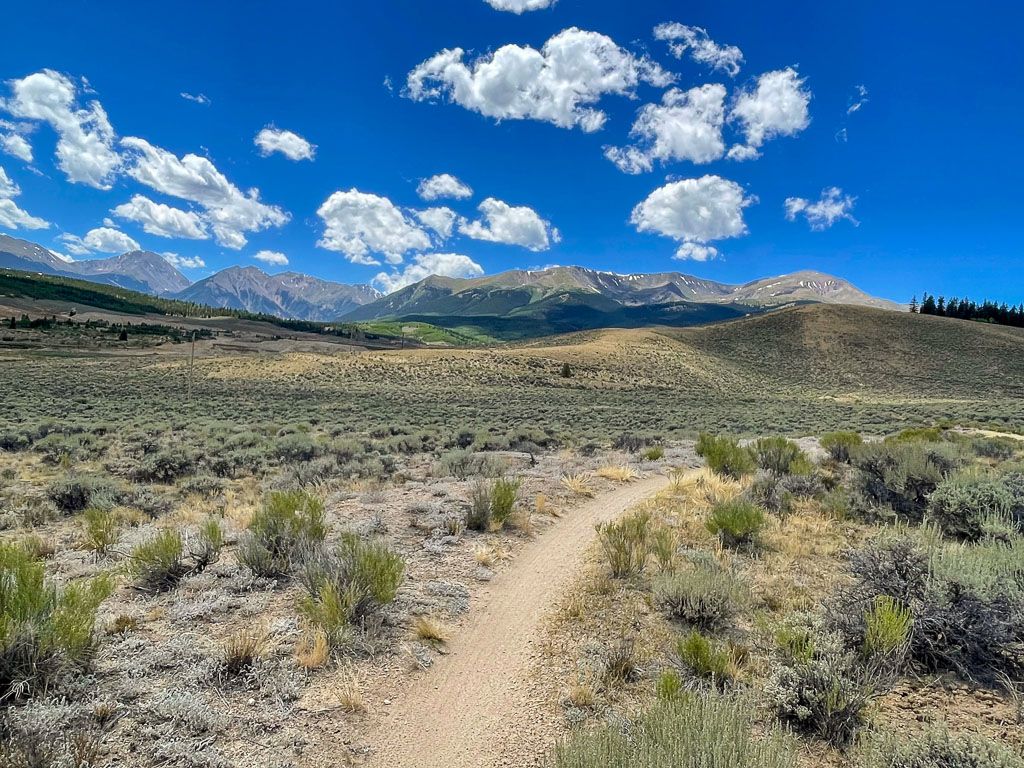
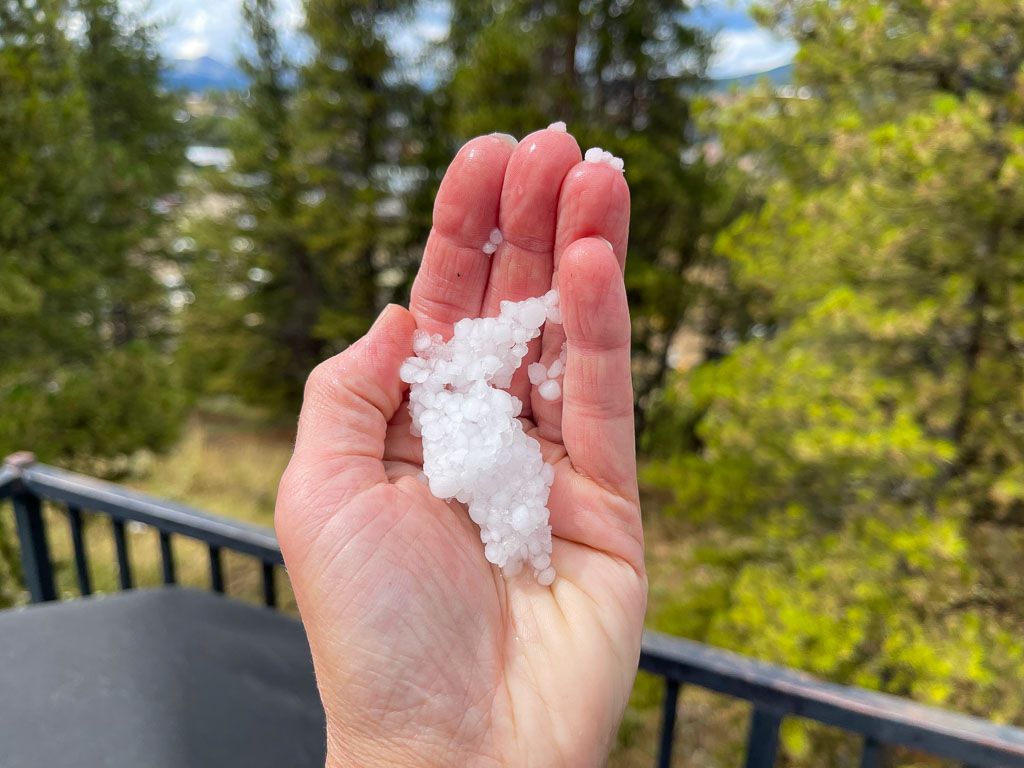
The singletrack exited onto a short section of pavement before we turned right onto a relatively smooth gravel road that would ascend to some fantastic views of Twin Lakes. But in the race against the first-time cutoff, I pedaled for my life. I heard a helicopter circling, and within seconds, the lead group of what seemed like a dozen pro riders swarmed past us, already on the return trip. The sound was unforgettable, free hubs spinning and gravel crunching en masse. I looked for Keegan Swenson, who I assumed would lead the pack, going for his third Leadville win and attempting to set a new course record. Not seeing him, I imagined he must've had a mechanical or some other issue keeping him from the front.
I was wrong!
He was having the Leadville of his life. He was so far ahead of the group that he was returning on the relatively new route change that diverged inbound riders onto the pavement while I was still outbound, descending the single track. Keegan finished the race in 5:43:31, obliterating the previous course record by 15 minutes. Sofia Gomez Villafane won the women's field in 7:09:48 and, much like Keegan spent a large part of the race solo.
Lifetime's coverage of 2023's race leaders.
Of course, I'd find all that out later. Right now, I had to focus on getting to Twin Lakes and not getting run over by what had now become two-way traffic of laser-focused descending elite cyclists that don't seem to need brakes. Climbing that dirt road, I asked Eric to borrow his legs and lungs and Mom for her heart and unwillingness to give up.
Pedaling furiously into the wind across the Twin Lakes dam, I expected to see a colossal timing arch to serve as a visual. There wasn't one. So, I rode as hard as possible until I finally crossed the timing mat. I couldn't help but celebrate! I pumped my arm in the air and shouted, "WHOOHOO!"—people were cheering and clapping—they knew this was a tense point in the race for riders coming through. This was not the finish line, but I really wanted to climb and descend Columbine that day, even though my pacing for a 12-hour finish was already dicey.
I looked around for my Twin Lakes crew, Chrissy and Stro. Despite seeing photos of the tent, my brain was having a hard time focusing on picking them out of the crowd. It felt like ages, but it wasn't. I spotted them. Stro immediately swapped out my bottles and admonished me for not drinking anything…he was right! I'd only taken in about 50 calories of drink mix in the last hour plus, and maybe one snack. Not good. I started eating and drinking as much as I could. Some local NICA kids were also helping; we filled my pockets with food, brushed the chain, and Chrissy raided my warm clothing bag and picked out a vest for the Columbine descent, and I was off!
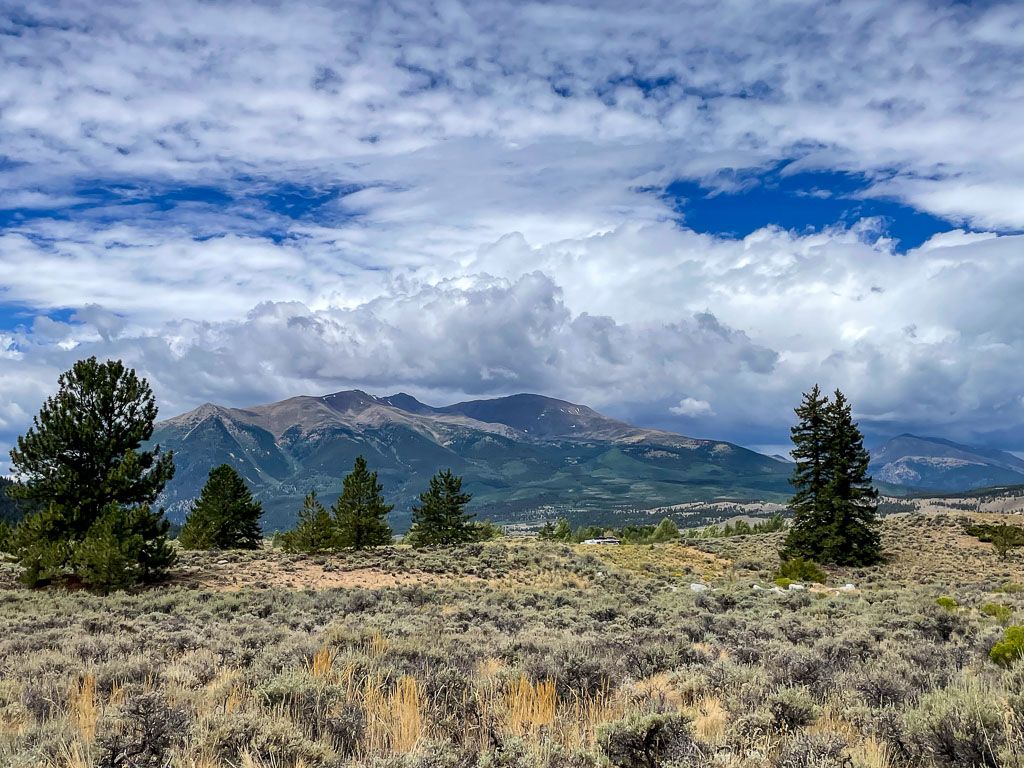
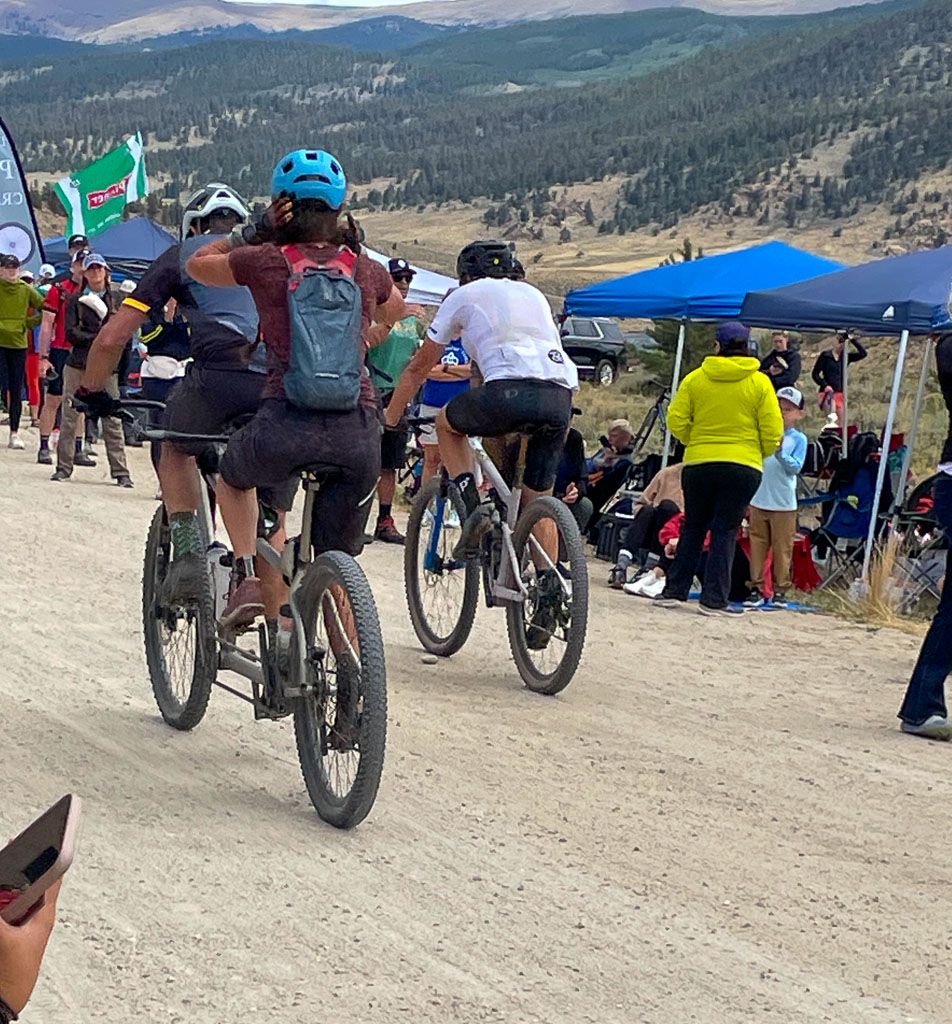
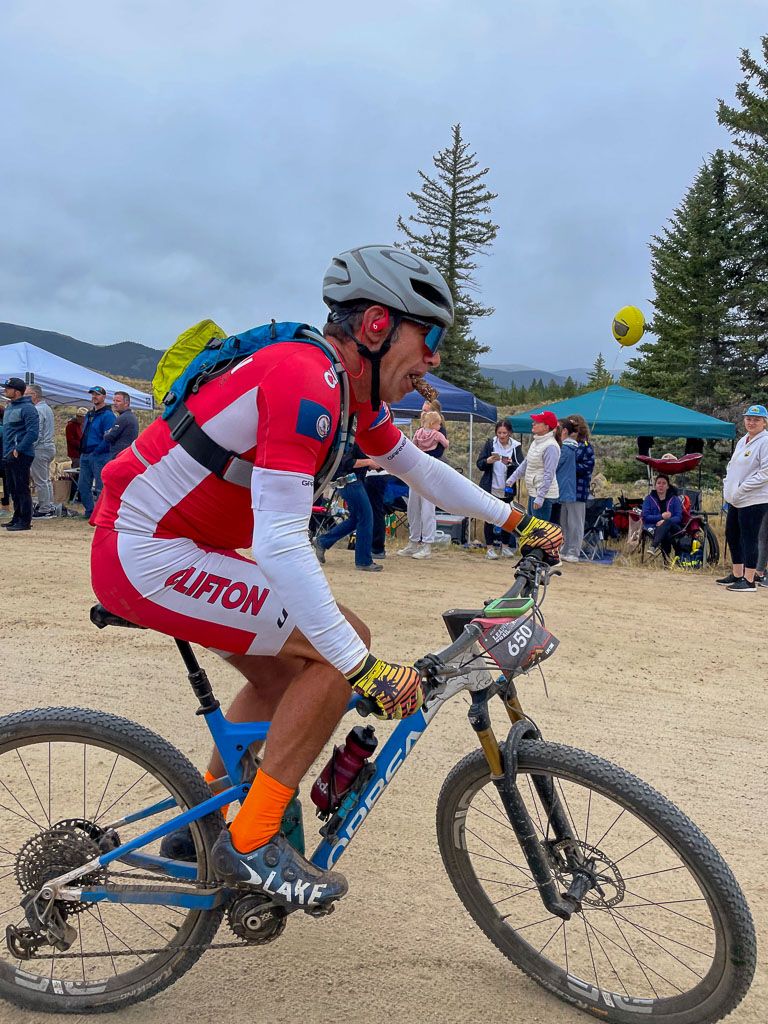
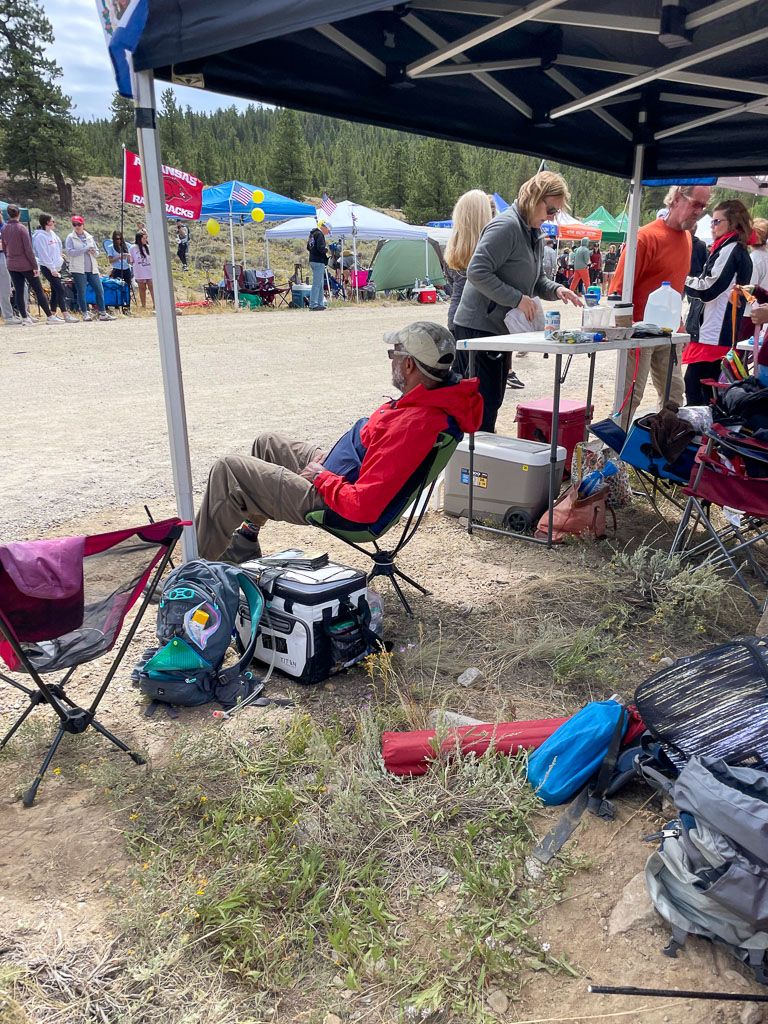
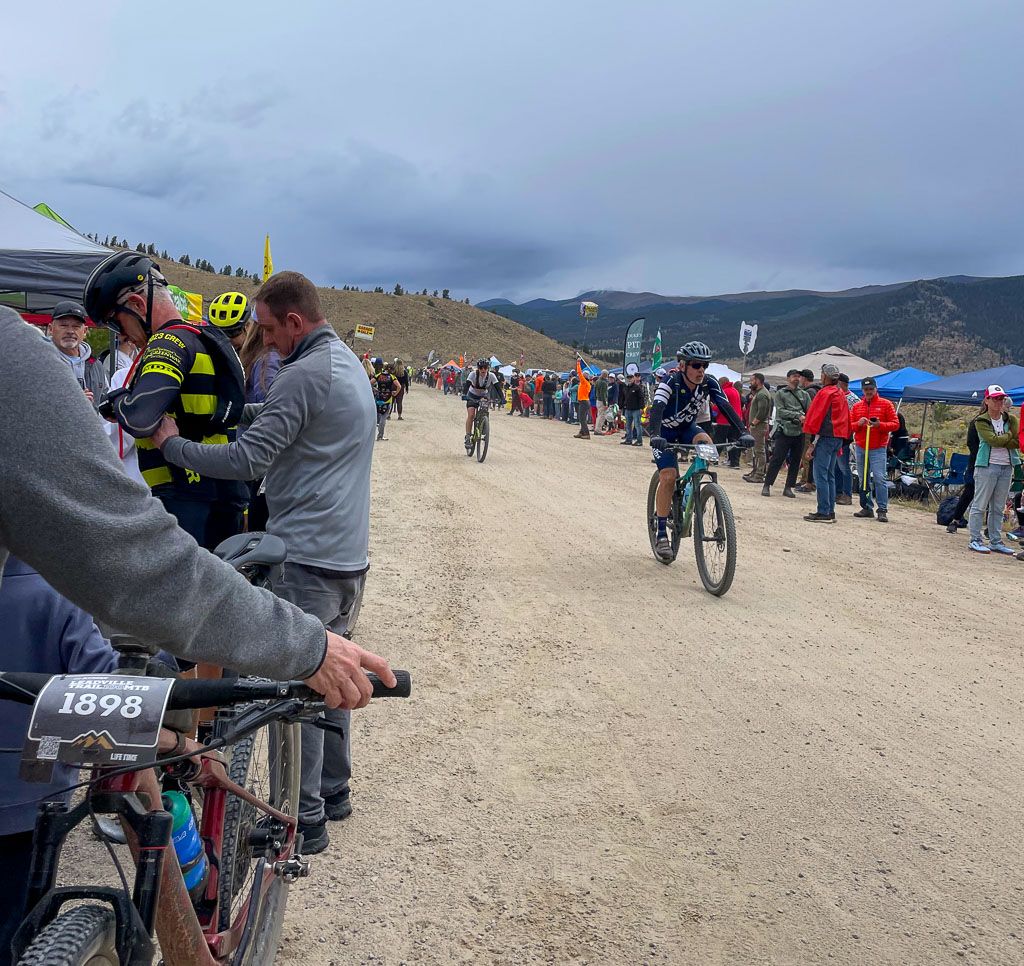
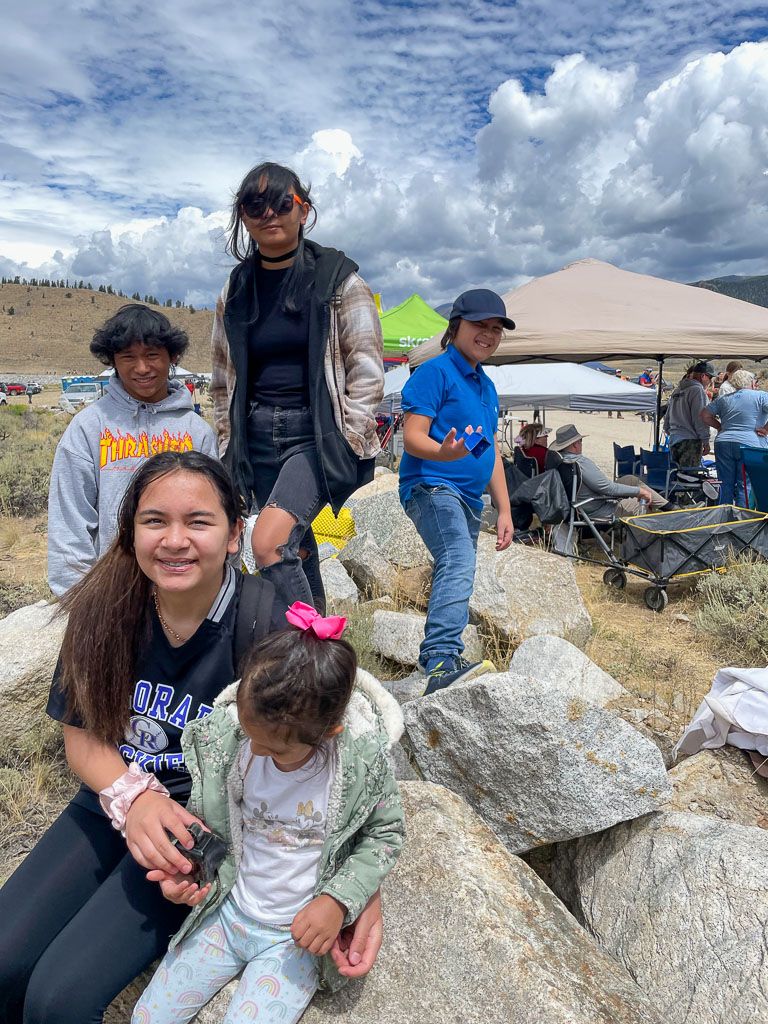
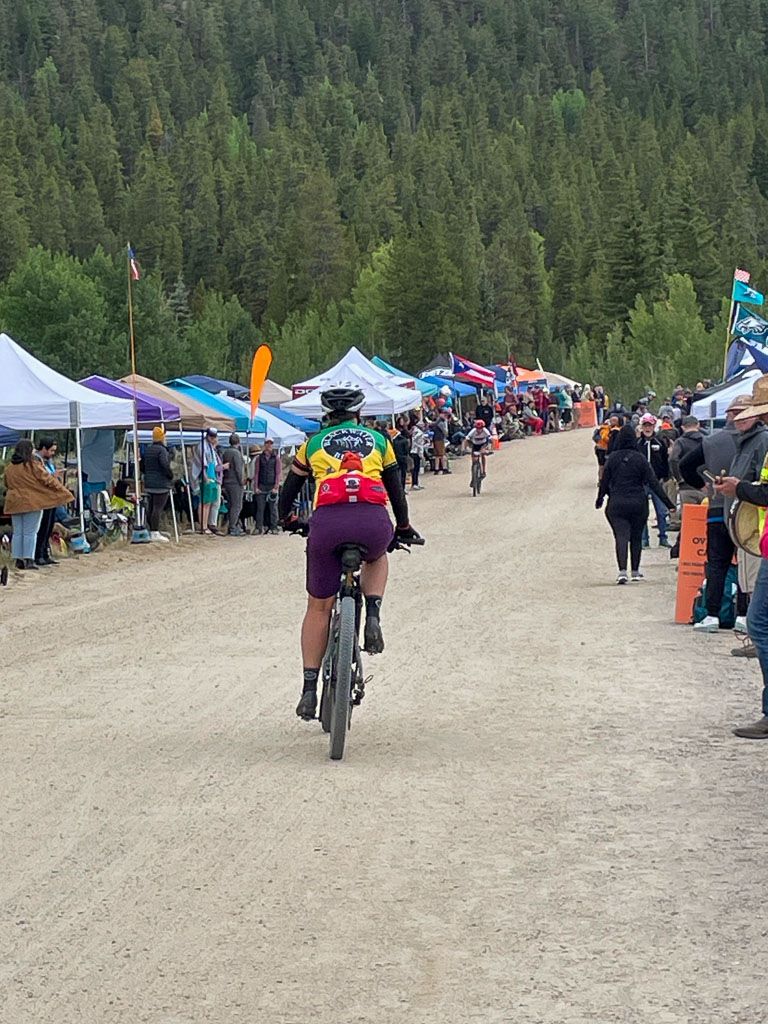
Support crew, family, and riders make the Twin Lakes aid station the place to be!
Ascent of Columbine
My feet were cold the entire day. There might've been a few moments on the Columbine climb when they weren't. Eventually, I peeled down my arm warmers. For a while, the sun came out. The smell of the aspen and cottonwood trees was invigorating. I was pedaling at a reasonable pace, nothing too intense, because I knew what lay ahead: 3,300 feet of elevation gain over the course of 7 miles. We'll leave the trees behind and spend about three miles climbing above 11,000 feet as we head to the course turnaround at 12,516 feet. I hadn't pre-ridden this section, and every part of me wanted the opportunity to get to the top.
While still in the trees, I pulled over for what might've been my third nature break of the day. I was frustrated. The extra hydration from the morning wasn't doing me any favors in the time department. As I got back on my bike, I came upon a fellow female rider, and we commiserated about how easy men have it in these moments. She was starting to feel the time pressure and commented as such. I realized I'd been completely ignoring the numbers on my Wahoo. She was right–we had miles before the infamous "goat trail" ascended to the turnaround. It's about a 1-mile section that is so chunky and loose that almost everyone ends up walking parts.
I did some quick calculations. It dawned on me that I wouldn't meet my 12-hour finish pace. Disappointment and sadness tightened my chest and started its usual expansion into my throat, making breathing even harder. I'd worked so hard for this and threw so much energy, effort, and money into this endeavor. I'd envisioned crossing that finish line for years now. But it wasn't going to happen. Tears were teetering. But 11,000 feet is no place to fall apart. I still wanted to get up this mountain. I knew the descent would be perhaps the greatest of my life. I could still make the Twin Lakes inbount cutoff and maybe reach mile 74. I kept moving forward, and the wave of emotion passed.
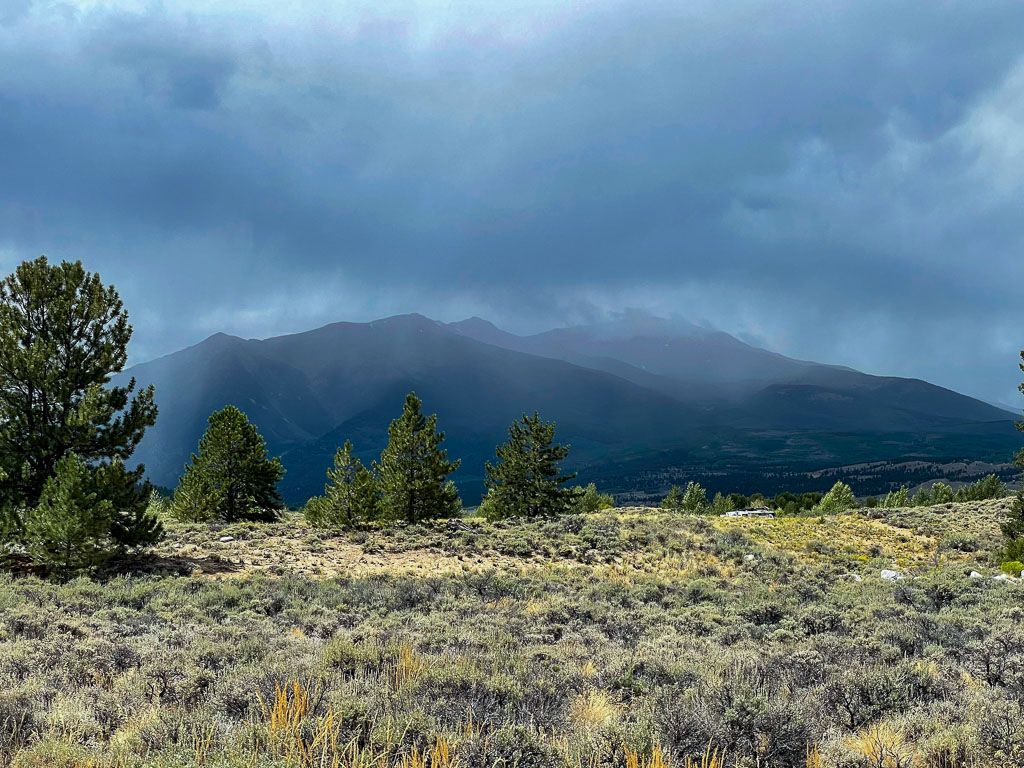
I made the most of my granny gear for as long as possible. Even though I hop-scotched with several riders who dismounted often for quite a while, I still preferred to be on the bike instead of off. Speed wasn't the goal; pedaling was.
Finally, I had to dismount. We'd reached the goat trail. For more powerful riders, this baby-head-littered gravel pit called a trail was just another grind. To my loosely formed pack, it was the beginning of the end. We would either reach the top or say, "screw it," and turn around.
I used this opportunity to take out my phone and shoot a quick photo. I didn't want to stop moving, so I held the bike in one hand and the phone in the other. I think the low oxygen was taking its toll. I had been playing music (sans headphones) for a while, and as I pulled the mini-boom box out of my top-tube bag for the photo, I saw the battery. Yellow. Single digits, no doubt. I had the phone for emergencies (and music) but forgot to put it in airplane mode. So, it was searching for a signal for the last six hours. Oops. I knew this was my last song for the day. And it was a good one. "Every step you take, every move you make, I'll be watching you." Before I once heard Sting remark that this song could go either way: creepy stalker vs. comforting dead person, I always imagined it to be the comforting dead person. Angels, I believe they're called. I don't have a religious faith, but I have no problem daydreaming that Eric was with me on that push up the Quail Mountain, and all his faith in me was valid. So I snapped a photo, turned off the phone, and had that song in my head for the rest of the race.
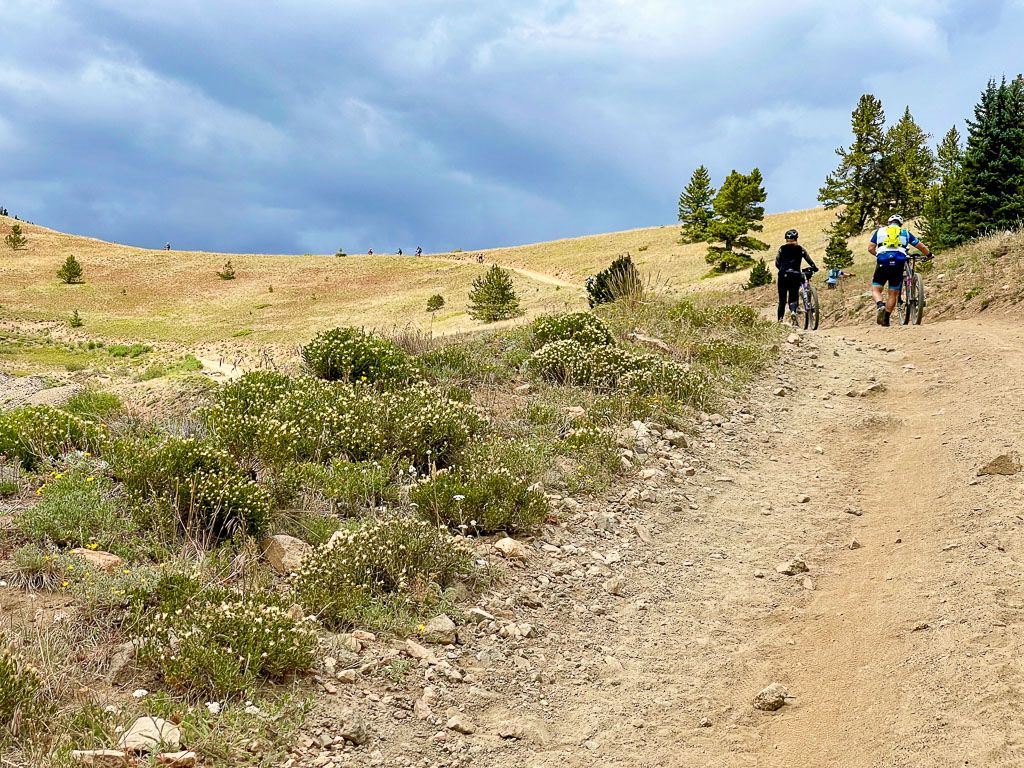
At this point, I also realized I wouldn't make the inbound Twin Lakes cutoff. My race would be over when I returned to the aid station. Acceptance came quickly; there was little surprise in this realization. While I wasn't experiencing altitude-induced nausea or light-headedness, I felt like I was wearing muck boots in a soul-sucking bog back home. Just plain slow. I offered sugar or salt to a gentleman about to pass out. He refused, muttered he didn't want to ruin my race. I responded: "My race is over, hon, I'm just ridin' till they yank me!" It was frustrating to keep going without helping him, but everyone rides their own race. I offered more than one person mustard as they fought off cramps and no takers. I thought about my brother and all my nieces and nephews who must be at Twin Lakes by now, waiting for my return, their role changing from cheering me on to cheering me up. At least I'd get big hugs from them and get to eat pizza sooner!
The atmosphere at the turnaround was oddly relaxed. By this point, we were all in the same boat. Why rush off from this goal we all worked so hard for? The porta-potty stuck out like a sore thumb, and I was sorely in need of it. But someone was in there, and for a while. I was about to burst and getting cold, dancing in place. A perceptive volunteer approached me with a huge black blanket: "Here, let me hold this up while you pee next to the porta-potty." Ok, I know a good deal when I see one. I thanked her profusely, the Saint of Columbine Mine.
I moved on to fill up my water bottles. I was surprised to see a newly familiar face! Ann Stanek, founder of Harperrose Studios in Leadville, is an endurance athlete with a couple of belt buckles of her own. We chatted, and I was surprisingly bubbly even though the finish line wasn't in the cards. She kindly asked me if my rear shock was still locked out…of course, it was! I was so grateful for that reminder as I unlocked it and took off down the mountain.
Flight of the Quail
Back to the goat trail, I began gingerly descending and saw other riders still approaching. Despite the rough terrain, with gravity on my side, I was starting to have fun. Surprisingly quickly, I was back on the gravel road, and it was time to let it rip. Oncoming traffic had ceased, so I had the luxury of taking the corners however I wanted. I considered practicing staying right but opted to have fun instead. The miles flew by. This is why trails often seem like they are all uphill. One spends so much more time climbing than descending!
I had a blast. It took me almost three hours to climb the seven miles I'd just descended in 35 minutes. But my ride wasn't over. I still had four miles before Twin Lakes Dam. And honestly, those last few miles were the toughest of the entire race.
Into the Wind
I felt like I was in Kansas but on a bike. My ticket home was a straight-as-an-arrow paved road piercing through the gaping valley. I must've had a tailwind on the way out to Columbine, but now I was facing the fiercest headwind I'd ever experienced. I felt like I was wearing a parachute. I'd lost most interest in pedaling, to be honest. It seemed futile, and the roadside vegetation was so monotonous that it felt like I was going nowhere. If I was a faster rider, I might been here with a group, and I can see how that would be essential. Trading the lead with even two or three people would've saved so much energy. But we were all too spread out and on our own.
Heading back into tree cover approaching Twin Lakes, I felt like pedaling again. I might as well have fun on this undulating 4x4 road. Coming upon the aid station at this point in the day is like breaking down a film set or concert venue. Depressing. But this time, I quickly spotted Chrissy, Stro, and my family!
I was laughing. This whole thing suddenly seemed so absurd. Someone told me I didn't make the cutoff. That made me laugh even more. But now it was time for the official act of acceptance: giving the race official my timing chip. As I approached, he said, "I know you don't want to see me right now." I felt so bad for him! I imagine folks who had come with seconds or minutes holding them back were distraught. But I had accepted this moment miles ago and just had a blast pre-riding Columbine for next year, and I told him as such. His encouragement as he ripped off my timing chip made for the most positive yet disappointing experience I can remember.
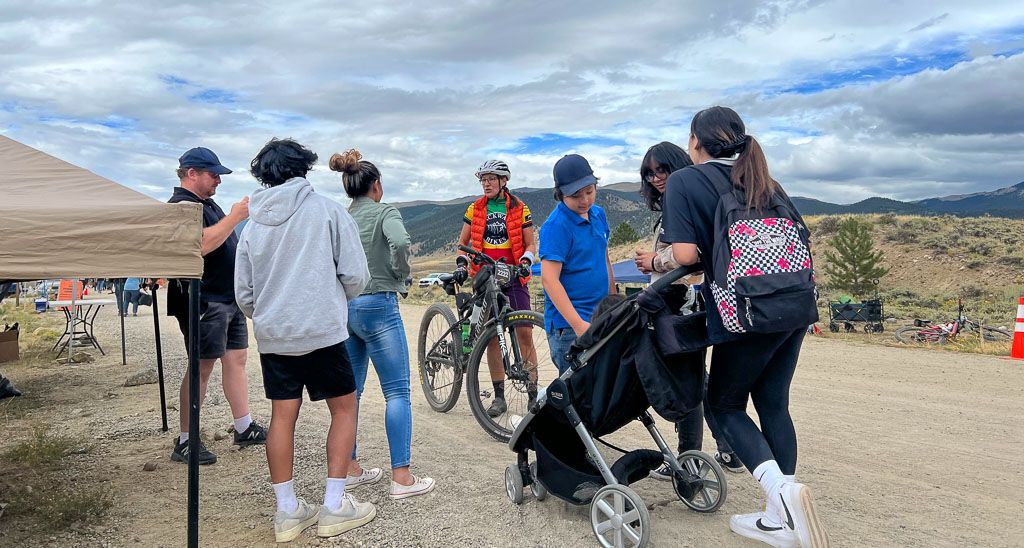
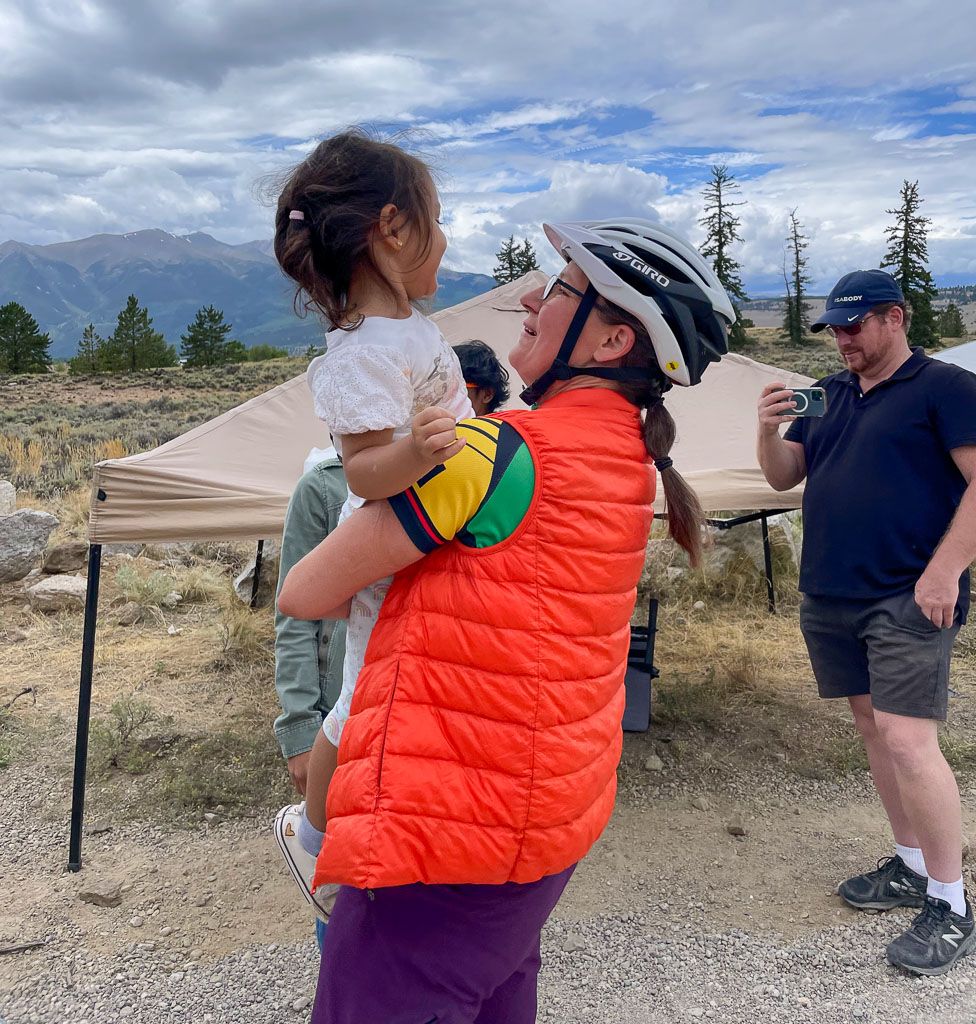
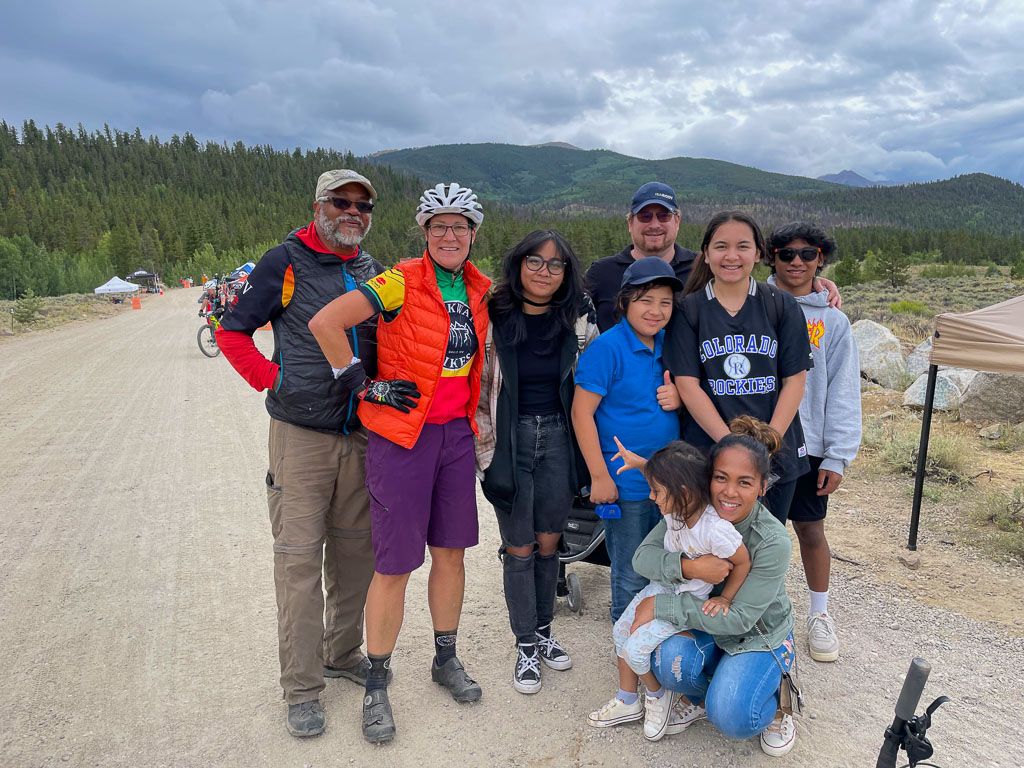
Facing Failure
The race was over a month ago. I've been stuck in the wilderness of that open valley, the force of the block headwind taking its toll for a while now. The euphoric feeling of accomplishment from riding 63 miles, climbing over 7,000 vertical feet, making the turnaround at 12,516, and feeling good enough to ride my bike the next day wore off quickly. The disappointment in not finishing has overtaken me more than once. The uncertainty about my van returned; I had no way home for a while. It's now the end of September, and the van is still in Colorado, but at least I am back home in West Virginia with my friends, dog, and bikes. I spent an extra week in Broomfield with the family, and it was precious time that I'm so grateful for.
It's hard to know if my performance illustrated what I was truly capable of. The van breakdown, which started seven days before the race, resulted in significant emotional and physical stress. Was I so happy to be at the start line that I relaxed too much during the ride? Was my sudden aversion to the Wahoo numbers just a way to enjoy the ride rather than race my ass off? Or was the finish line always going to be elusive this year, with or without the van drama?
Physical fitness isn't a panacea of immunity from life and all its unexpected problems and whizzing curveballs. But it helps. For example, at 12,500 feet, every racer had effectively 30% less oxygen available to them than at sea level. Those with greater fitness may still have lost power but were starting from a higher level. They could absorb the loss of power and still meet their performance goals. I could not.
The bottom line is that my current fitness wasn't strong enough to overcome all the curveballs and challenges of Leadville 2023. And it's not for lack of training, hard work, dedication, or even progress, for I embodied all that over the last year. However, I still failed to cross the finish line. Next year will be different. As long as my legs, lungs, and heart support me on two wheels, I'll do everything in my power to traverse all 104.8 miles of the LT100.
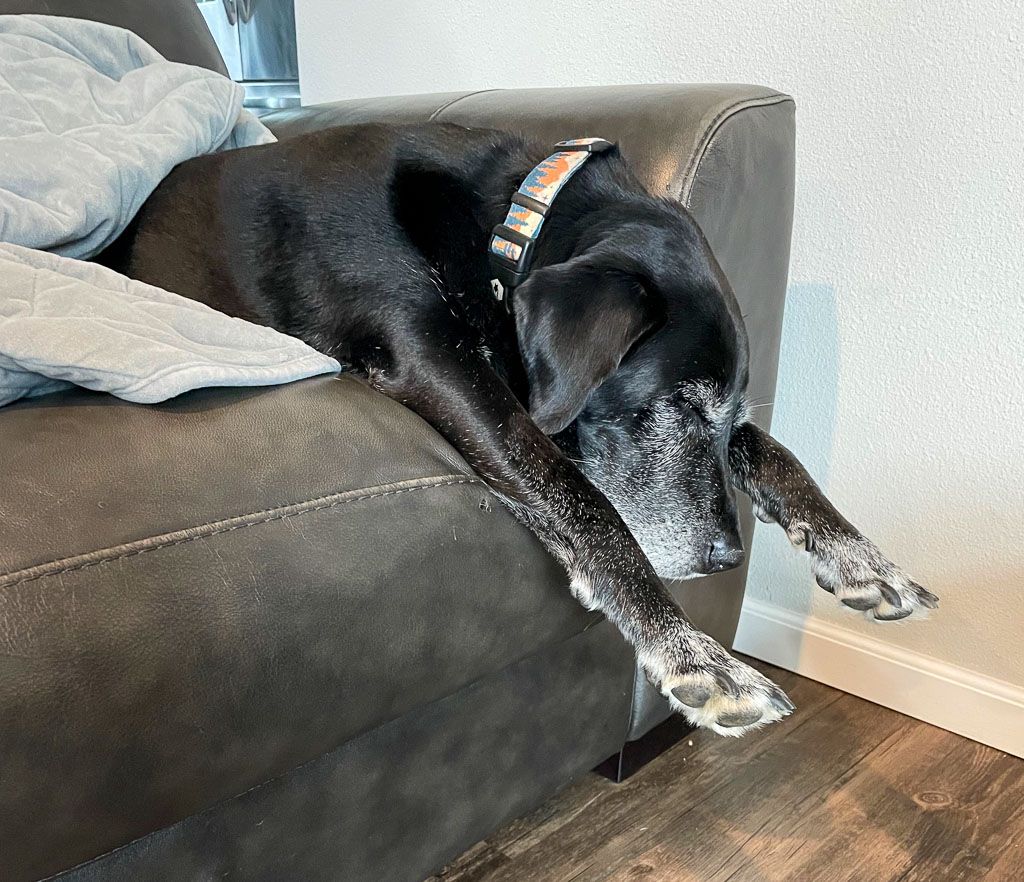
Follow me on X @vweeks and Instagram @victoria.weeks for daily meanderings.
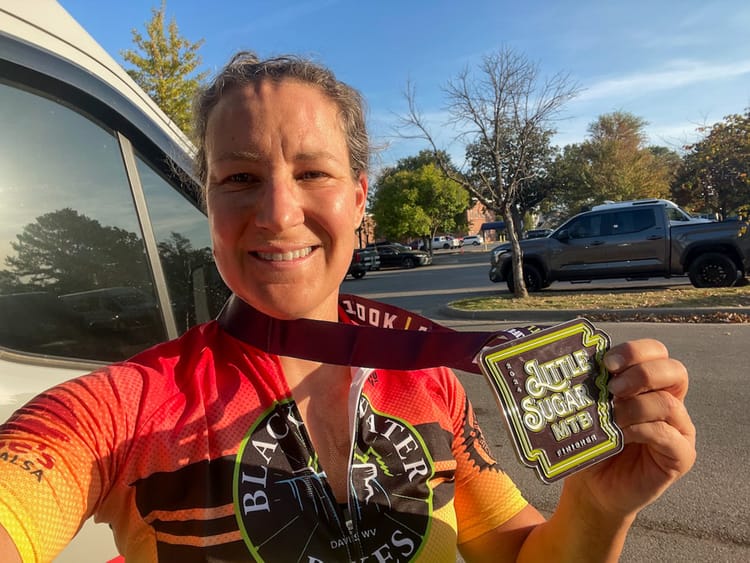
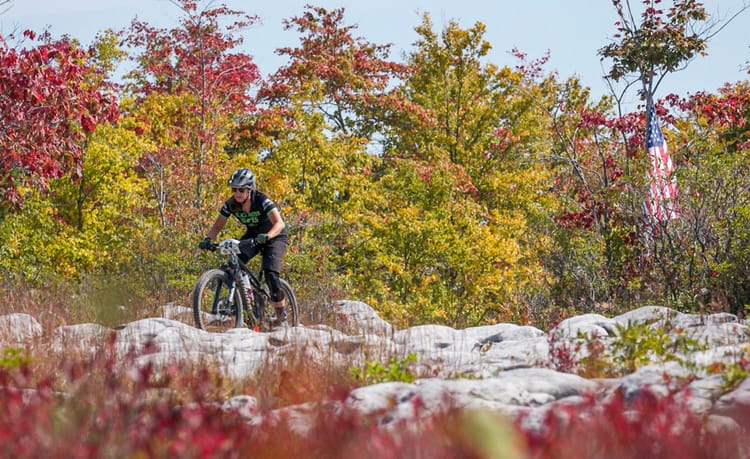
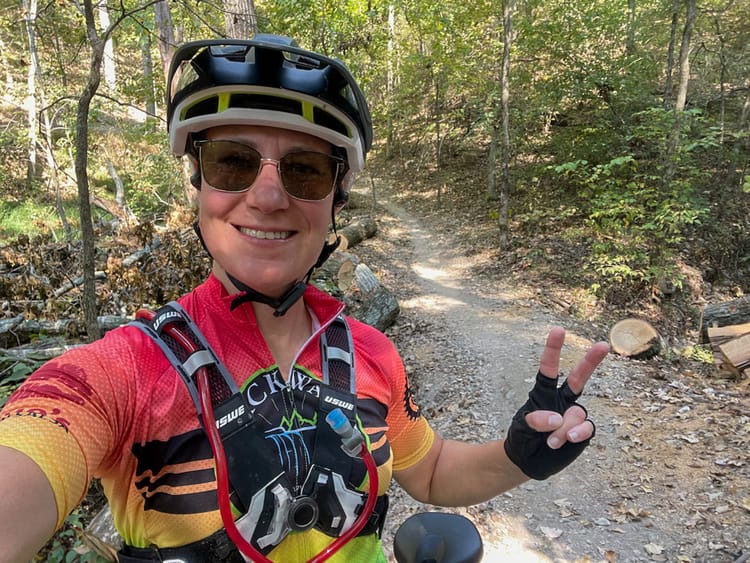
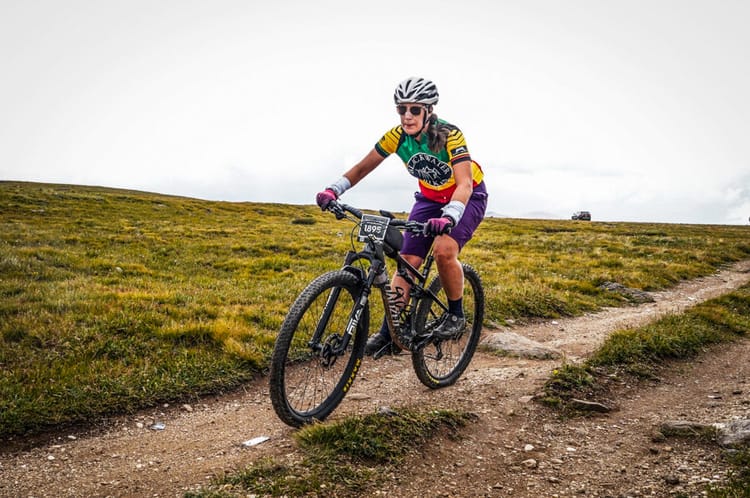
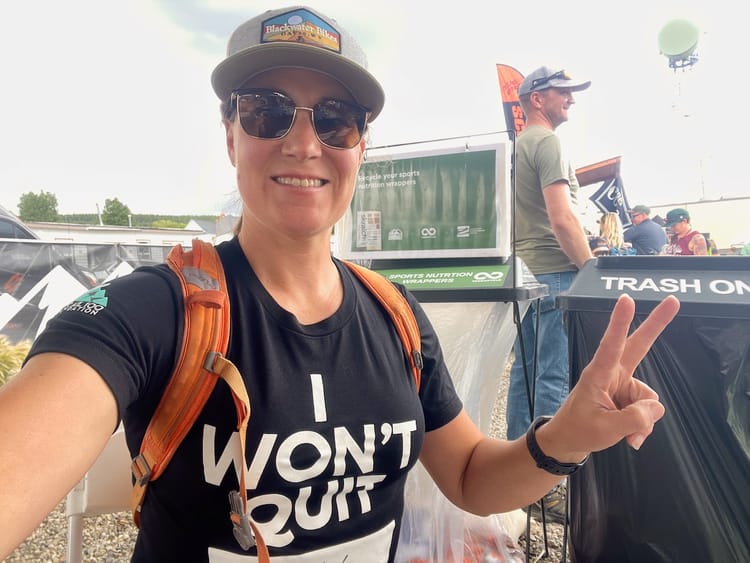
Member discussion